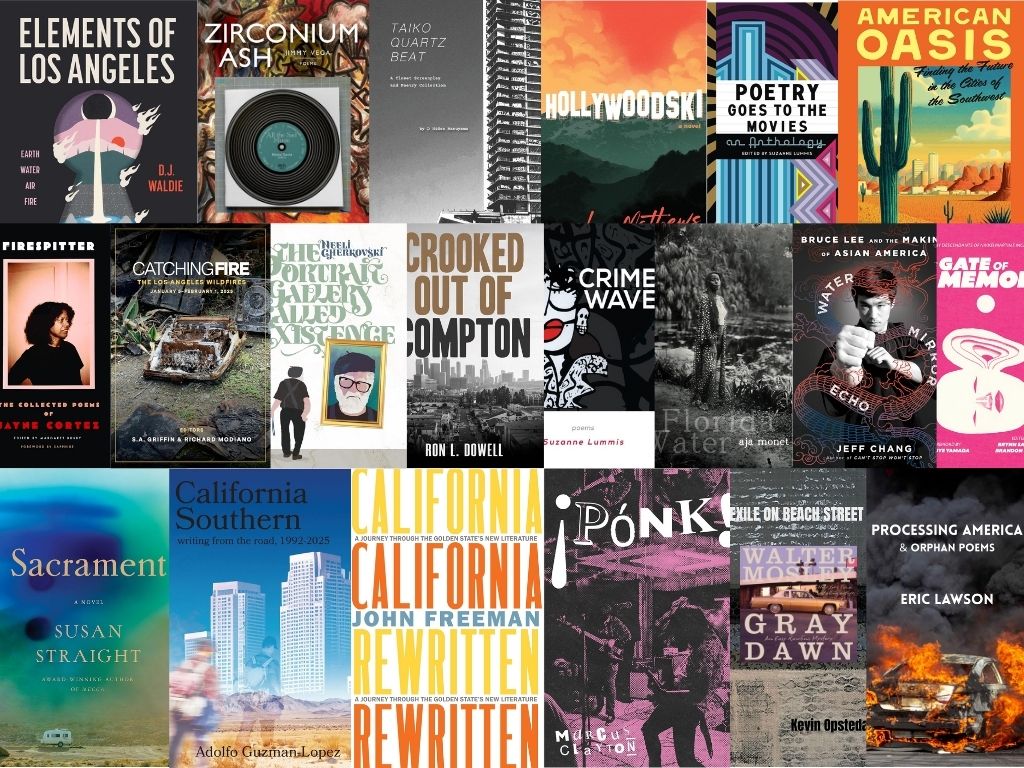Los Angeles has a rich history of attracting and nurturing some of the most interesting and talented individuals, so it’s no surprise that the City of Angels draws in this glamorous spirit and mirrors it. While the stars may come and go, their essence leaves a lasting impact, touching every corner of the city. After all, a star, even after it fades, can spark a supernova, spreading its brilliance far and wide, leaving behind a legacy that continues to light up the universe long after it’s gone.

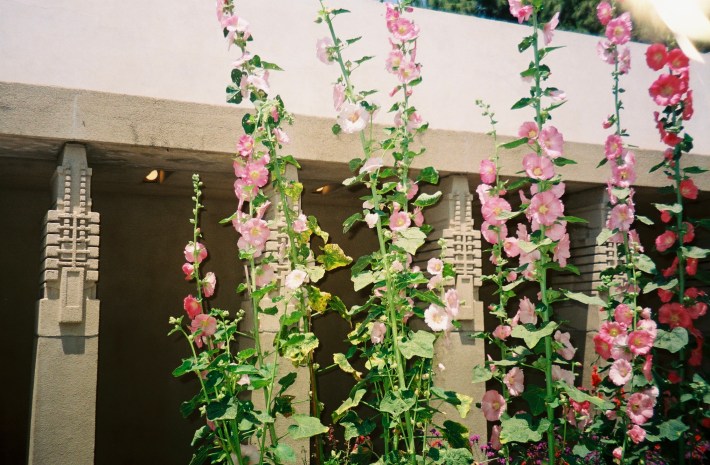
The Hollyhock House: Wright’s Revolutionary L.A. Debut
This stunning Frank Lloyd Wright creation is perched atop a grassy hill on the iconic Hollywood Boulevard. Wright devoted his life to inventing styles of architecture and design, and the Hollyhock house is nothing short of a testament to his ambition. The architectural genius laid his structures across all of Los Angeles. However, this one was his first L.A. commission. Built between 1919 and 1921, Hollyhock House was designed for a notable nonconformist, oil heiress Aline Barnsdall. Known for her anti-establishment views, the wealthy patron of the arts envisioned the house as the heart of an artists’ community on Olive Hill in the neighborhood of Los Feliz—and so it was. Surrounding the Hollyhock House lives the vibrant cultural and recreational Barnsdall Art Park, including its theater, art gallery, art center, junior arts center, green spaces, and gardens, accompanied by stunning city views.
“California Romanza,” Wright described the house’s design, referencing the musical term “romanza,” which is a sort of sentimental ballad but also refers to “the freedom to make one’s own form.” Fittingly, the structure gives an entirely new definition to “indoor-outdoor living” with its use of organic materials, emphasized by the living room’s moat surrounding the seating area with a stream of water. The Hollyhock House’s natural environment undeniably emphasizes organic and local materials and integrates open spaces, extensive glass, concrete walls, and wooden decorative motifs inspired by a California scene.
This timeless tribute to California is one of the most interesting houses turned museums to visit in contemporary times due to Wright’s custom-designed furniture and fixtures. While some of Wright’s or other notable architects' stunning buildings are maintained for today’s Angelenos to explore, this one is fully furnished with decor and furniture from the era to match.
ADVANCE TICKETS RECOMMENDED FOR IN-PERSON TOURS.
4800 Hollywood Boulevard. Los Angeles, CA 90027
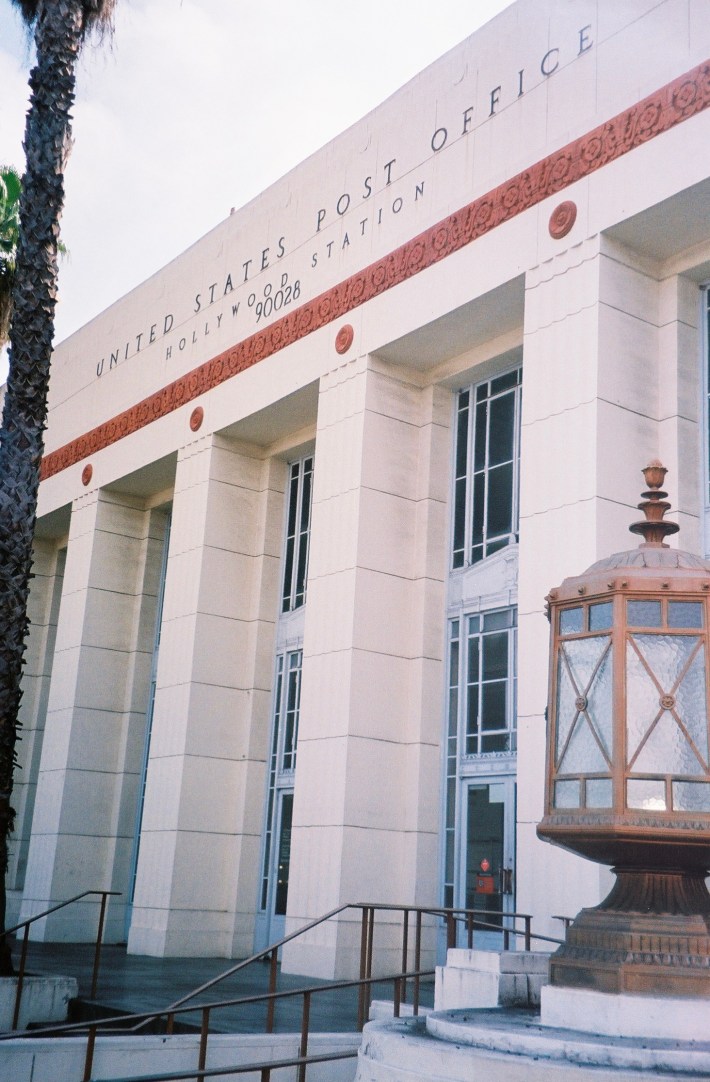
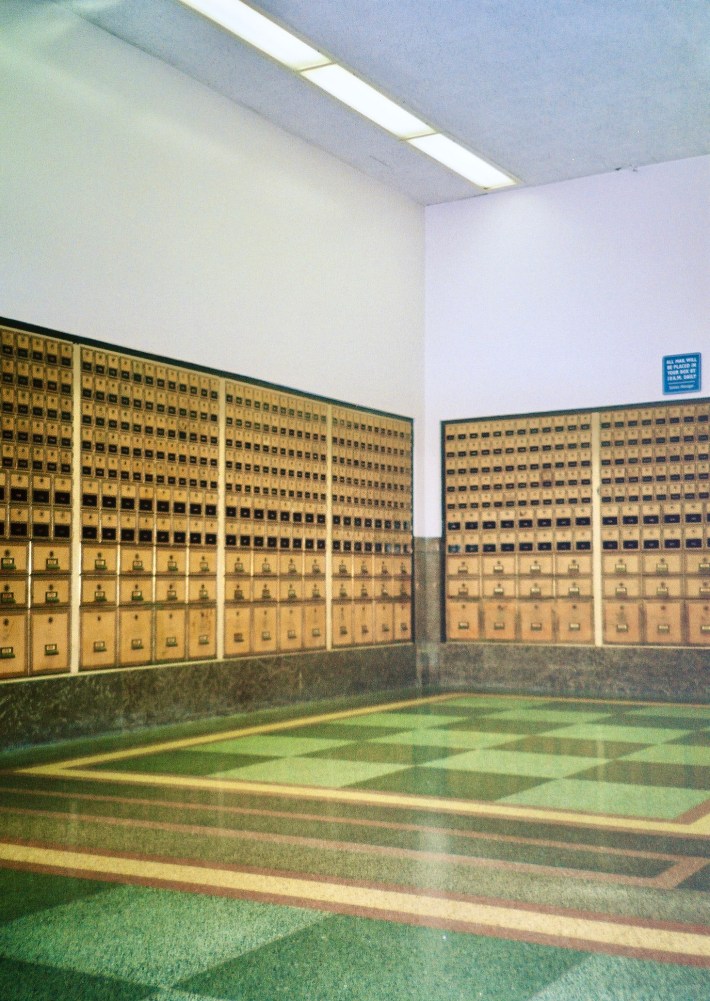
U.S. Post Office Hollywood Station: A Timeless Depression-Era Marvel
Acknowledged by Architectural Digest last year as one of “the 11 most beautiful post offices around the world,” this mailing room in Hollywood exhibits the “starved classical” architectural style that most federal buildings did during the Great Depression. Around this time, in 1937 a New Deal Agency commissioned American Architect Claud Beelman to put up the post office. Among other iconic and historic L.A. creations such as The Culver Hotel and The MacArthur, Beelman got to work designing the streamlined Art Deco marvel that is Hollywood’s post office. Not much has changed about the structure since the day of its completion, therefore it’s earned its spot on the National Register of Historic Places.
The windows feature stunningly classic wooden frames with multiple panes of glass in a grid pattern, showcasing traditional style, multi-pane windows. Also significant regarding the interior are the green-checkered flooring and bronze accents, reminding contemporary Americans of the time during and succeeding the Great Depression. If not the bronze mailboxes and checkered floors, then most notable is the exterior. The Art Deco style definitely shows the influence of the structure’s birth year—1937. The design of the building is noticeably symmetrical, with streamlined corners, a vertical emphasis, and a classical influence. Of course, the building is primarily Art Deco, but it also incorporates clear classical elements. The most interesting about this scene is the terracotta detailing. The red ornamental frieze and other decorative elements are quintessential Art Deco, making the mailing room a true relic of its time.
Uniquely, one of the final sights that a package sees before parting ways with its sender is Johnny Grant’s star. While most notable stars live along the legendary Hollywood Walk of Fame, the star of the man known as the “Honorary Mayor of Hollywood” is right outside of the post office’s entrance.
1615 Wilcox Ave, Los Angeles, CA 90028
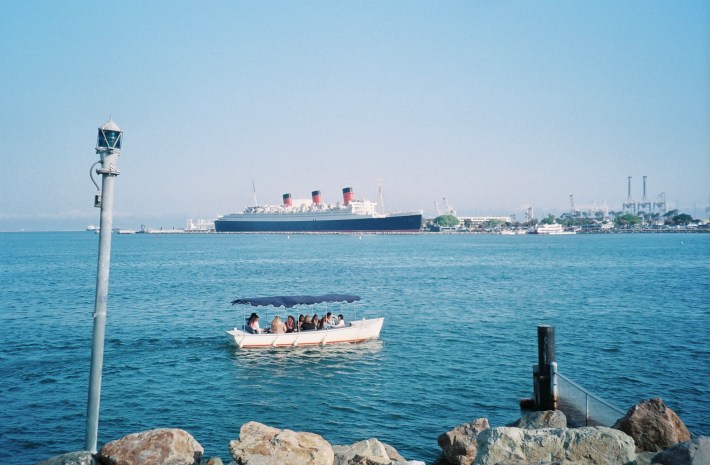
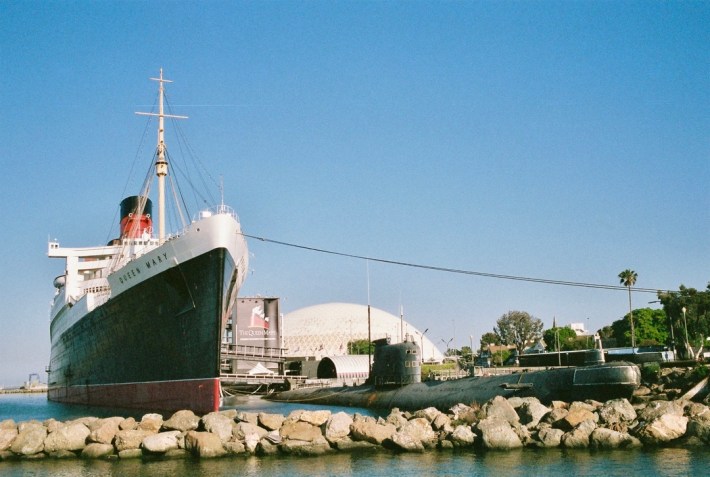
The Queen Mary: A Floating Palace for the Rich and Famous
If this beauty looks familiar, it’s likely because she was the only vessel that could come close to resembling the Titanic. As a result, it was used in several Titanic moves to portray her. But that isn’t the only relationship between the two - In 1934, the White Star Line shipping company and owner of the Titanic merged with the British shipping and cruise company, The Cunard Line, which operated the Queen Mary. Having formed Cunard-White Star Line, the Queen Mary was completed under the ownership of this merged company.
Legend has it that her original name was Queen Victoria until King George refused his blessing. "We have decided to name our new ship after England’s greatest Queen… My wife [Queen Mary] will be delighted that you are naming the ship after her.” Ouch.
The stories of notable passengers are endless. Everybody from Bing Crosby to Audrey Hepburn made it a point to board the vessel. The British Prime Minister during WWII, Winston Churchill, famously studied the ship’s travel schedule to take advantage of every chance to board it. He even used the Queen Mary during WWII to frequently meet with President Franklin D. Roosevelt and other Allied leaders.
1126 Queens Hwy, Long Beach, CA 90802
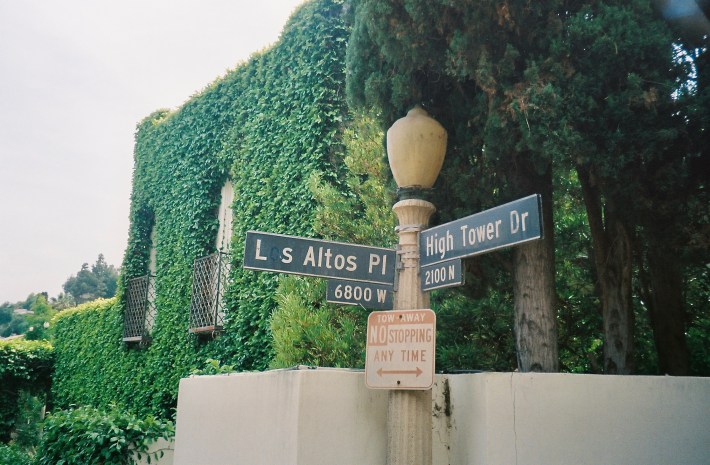
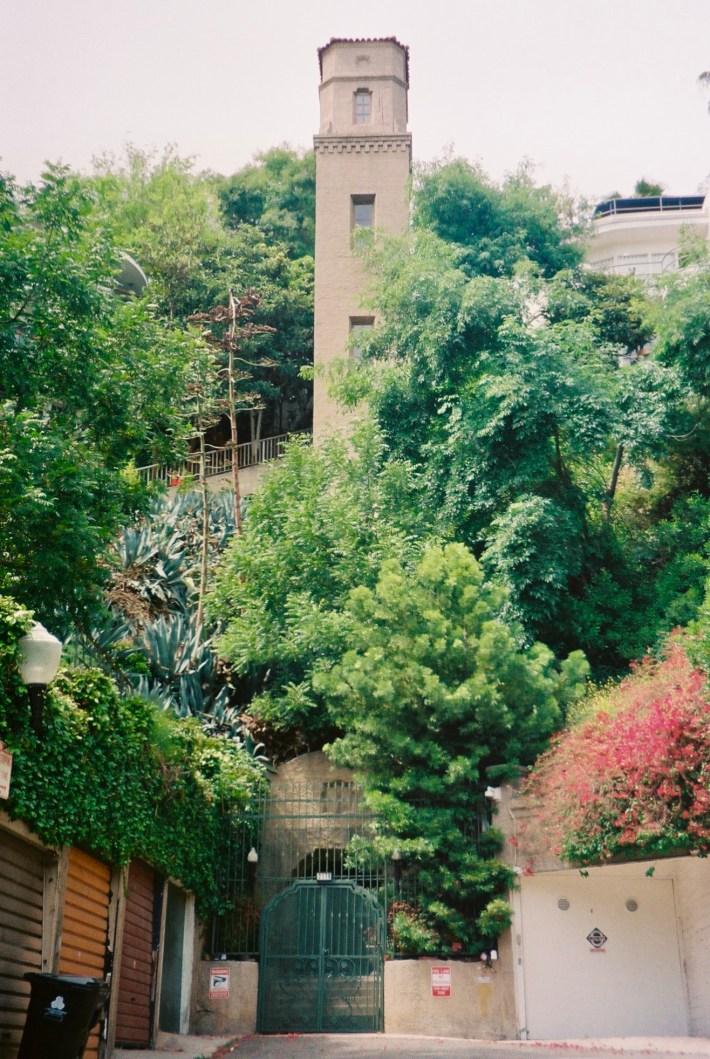
The High Tower Elevator: A Century-Old Solution to Hollywood Hills Living
The Elevator towering over a Hollywood neighborhood might give any passerby pause. The historic five-story High Tower Elevator was built at the end of a cul-de-sac around a century ago to spare the neighborhood’s residents from having to huff and puff from their car to their front door. These surrounding homes were designed by the talented Carl Kay and built between 1935 to 1956.
The structure, inspired by Italian bell towers, exclusively sends residents into the sky, providing a beautiful view of Los Angeles. Consequently, visitors have 2 options—to charm the pants off of a conveniently-timed resident just arriving home, or take the long way. Even without a key to the lift, it surely is worth a visit. In part, because it feels like a little magical town and also because it feels slightly like a forbidden thrill. The street left of the tower, in the same cul-de-sac, takes non-key holders the scenic route, which is actually a brisk and beautiful walk to the view.
2178 High Tower Dr, Los Angeles, CA 90068
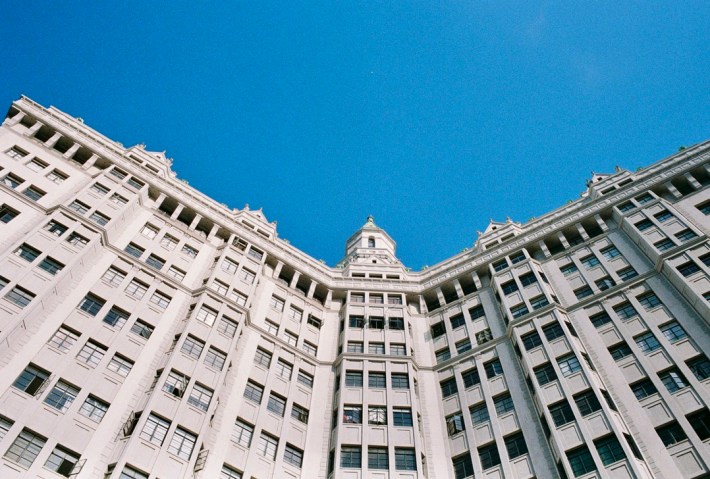
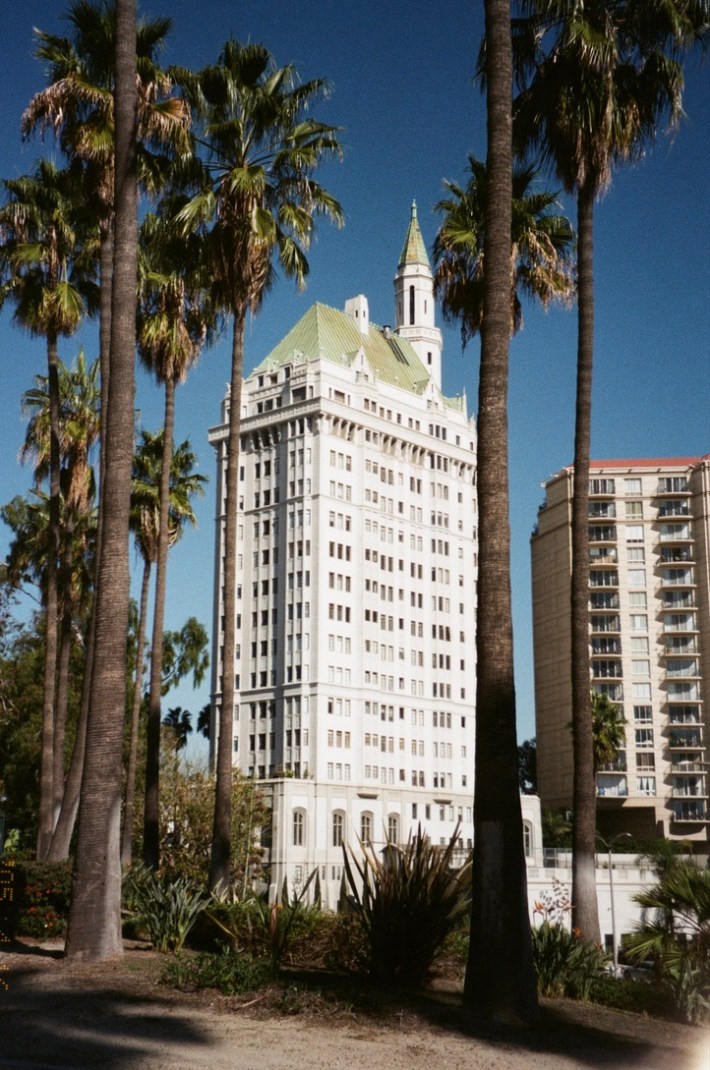
The Villa Riviera: Glamour, Gargoyles and Secret Stashes
This building has lived many lives, from serving as housing for top Naval officers during WWII to a hot hangout spot for the stars. Today, the Villa Riviera is a stunning, gothic condominium complex. Almost a century ago, the decorative gargoyles watching over Long Beach’s shoreline were perched on what was proud to be “the finest and most modern of all California’s resident-owned apartment hotels.” Architect Richard D. King called his combination of Italian and Renaissance inspiration “Tudor Gothic.”
When the 385-foot tall complex was the tallest in all of California, 20th Century Fox chairman Joseph Schenck famously bought the hotel as a gift for his then-wife, silent film star Norma Talmadge. During her managerial days, some of Hollywood's most iconic faces could be seen there: Elizabeth Taylor, Fatty Arbuckle, and even Charlie Chaplin were regulars at Talmadge’s establishment.
As a result of the Prohibition on alcohol, the Art Deco windows created a stunning bar featured on one side of the Villa Riviera’s cocktail lounge, the area now a hair salon. An epic accidental discovery within these art deco walls in 2002 uncovered a secret safe behind a phony wall in the 15th-floor closet of a man named Don Stone, a consumer electronics applications engineer. This authentic Prohibition Era relic shows how freely drinks flowed through the residential tower. And for an anecdote that will impress Angelenos who know that the 30-something miles from Hollywood to Long Beach might as well be a cross-country road trip, Stone’s apartment view in 2002 was described to feature “the Hollywood sign from one window and Catalina Island from another.”
800 East Ocean Boulevard. Long Beach, CA
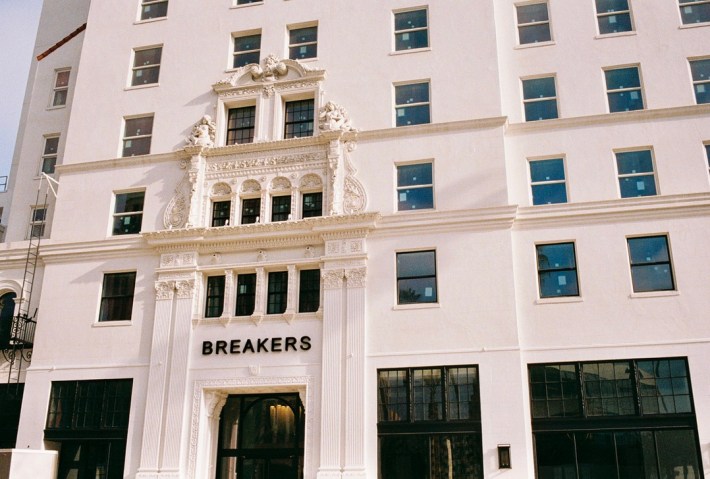
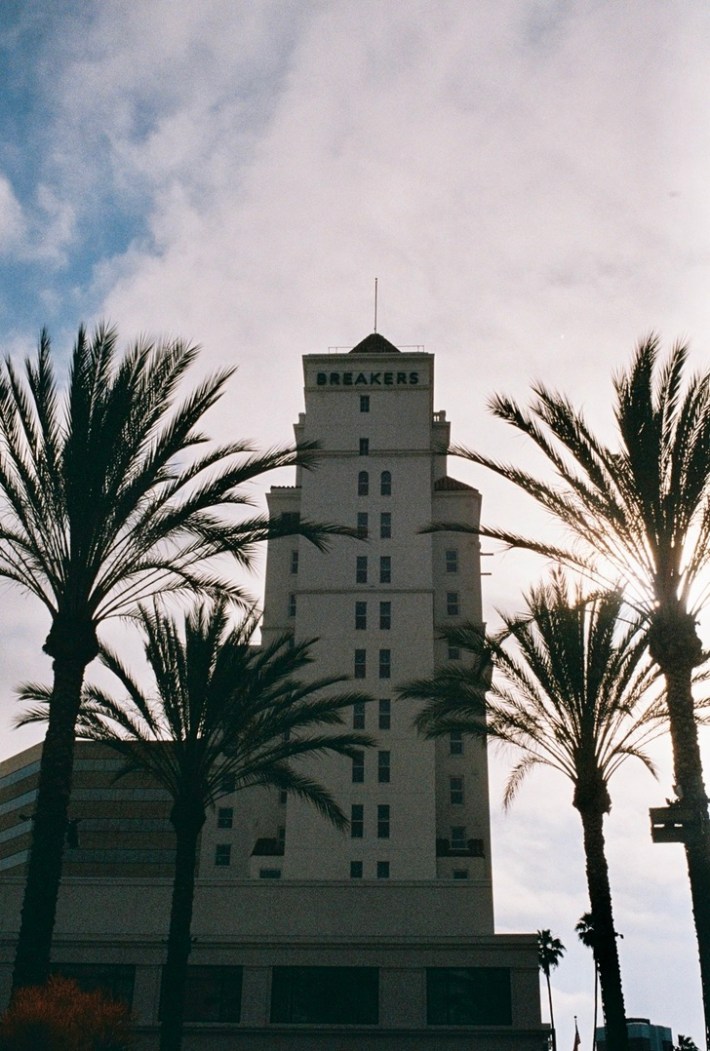
The Breakers Hotel: Ninth Time’s the Charm
The rise and fall of the Breakers Hotel is a fascinating series of unfortunate events. Initially built in 1926, it quickly became the most prestigious hotel in the area, attracting wealthy and notable guests. This says a lot, as Long Beach had an iconic era from the 1920s until the mid-20th century, establishing itself as a major cultural, economic, and social hub. The Breakers is a significant cultural landmark representing the growth and development of Long Beach as a coastal city, accommodating Hollywood royalty such as Clark Gable and Humphrey Bogart.
The original building was rumored to cost $3 million, including a famously unusual feature—radio broadcasts in each room. “Each room in the new hostelry has four radio jets, each connecting with the radio-receiving room in the tower,” The Los Angeles Times wrote in a 1926 article. “By plugging in on any of these four jets, programs from broadcasting stations are heard. If there is a particular program on the air that a guest particularly desires to hear, it is only necessary to phone the receiving room, and the operator will tune it in.”
Within a year of its opening, the Breakers Hotel was sold to an anonymous group of investors for about $1.7 million who had plans to do extensive remodeling. However, the start of the Great Depression and the 1933 Long Beach Earthquake forced the Breakers into bankruptcy. Though the earthquake didn’t cause significant damage to the hotel, it did cause over 100 deaths and extensive destruction to the city, also damaging the city’s tourism.
In 1938, Conrad Hilton bought it for $150,000, converting the penthouse into the historic Sky Room, one of the most popular Southern California restaurants. Faces like John Wayne and Rita Hayworth could be caught enjoying a luxurious meal at the establishment. During WWII, the rooftop gained two pillboxes with gun mountings in case the harbor needed defending, and the Sky Room became the official Airwatch headquarters for the city’s harbor.
The hotel was sold again in 1961. Airline investor Fred Miller acquired the Breakers intending to “recapture, for Long Beach, the beauty, dignity, and service of the city’s greatest hotel.” Miller was unsuccessful, losing half of his net worth, resulting in the hotel’s closure two years later. The hotel’s ownership moved around some more, ending with realtor Harvey Miller, who planned to turn it into a retirement home. This retirement home opened in 1966 and sold 1978 for less than $3 million.
Returning to the hotel business in 1982, the Los Angeles Times celebrated, “Its 60 years have been a roller-coaster ride of ups and downs, prosperity and penury, bright lights, and gloomy emptiness. Just now, its direction is up.” But again, the hotel was unsuccessful at drawing guests, didn’t profit, and closed its doors in January 1988. A year later, the city of Long Beach designated it a Long Beach Historical Landmark. Opening again in 1990, the Breakers reopened as housing for senior citizens, closing in 2015. The Sky Room reopened in 1997, closing in 2018.
Finally, in modern days, the historic Breakers Hotel will return in long anticipation this September. Mohammed Aslam, the security person in charge, described the renovations as “amazing.” “It’s taken seven years,” Aslam said. “But it’s amazing that you will not see anywhere else here in America.” Along with the Sky Room, the Fairmont chain, the Breakers Hotel & Spa will house five bars.
200 East Ocean Blvd. Long Beach, CA.
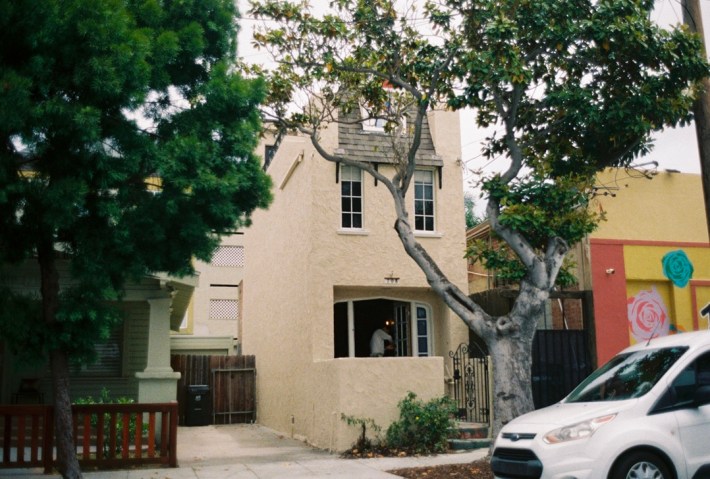

The Skinniest House In America: A Slender Slice of History
One of the skinniest houses in the entire country is an 860-square-foot, 10-foot-wide home right off of 7th Street. in the Rose Park neighborhood. In 1931, Newton P. Rummonds acquired the land for a $100 loan when a friend challenged, “I bet you couldn’t build a livable house on some 10x50 foot lot.” One year later. the skinny house was constructed
The Guinness Book of World Records and Ripley’s Believe It or Not recognized the registered city landmark as “America’s Skinniest House,” hardly beating the famously skinny houses in Boston and New York state. From 1977 to 1981, a public interest lawyer named William John Cox ran his business out of the structure.
Coming to life in 2001, Laurie Atherton, who lived in the Skinny House with her cats, shared with the Los Angeles Times, “It’s very livable. It’s not just a novelty.”
She moved the following year.
708 Gladys Ave, Long Beach, CA 90804
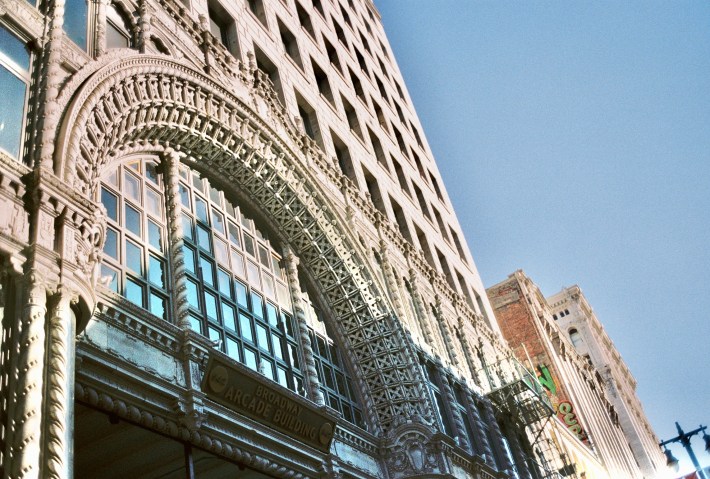
The Spring Arcade (aka the Broadway Arcade): Uniting Broadway and Spring, Past and Present
The history of this beautiful Beaux-Arts style building begins in 1883 when the Los Angeles school board purchased the site for $12,500 and birthed the Spring Street School. By 1904, the area had become so valuable that the land was put up for lease. That year, the Mercantile Place was created. This establishment was promised to be innovative and “something entirely new in Los Angeles development.” Developer C. Westley Roberts secured a ten-year lease and planned to add a new street, “cutting through from Broadway to Spring Street” to be an arcade, “faced on two sides by stores and business offices.” By 1905, Mercantile Place opened alongside “A Woodmen of the World” lodge hall, a MacDonald’s and Curtis-Newhall general newspaper/advertising business.
As things went on, a decade passed, and the property value went up significantly, from $400,000 to $1 million. Plans to sell the property were made by the school board. So, since the rent paid by the Mercantile Place tenant was only 2.5% of the plot’s value yearly, they decided to sell the property rather than renew the lease. In early 1914, they signed a renewable lease with the Mercantile Improvement Association for $3,500 monthly to avoid its vacancy while awaiting sale or development. A special election was held the following month to decide the property’s fate. Due to a low turnout, 2,003 votes favored a 50-year lease. Hundreds of Angelenos gathered in the Mercantile Place on Halloween in 1911 for what the Los Angeles Times called “the largest election crowd in the history of Los Angeles.”
By the start of the 1920s, the privately owned “street” was considered “Broadway’s ‘Appendix.’” A merchant described it as a quaint cove leading off of the main road. He reflected thoughtfully, “Right in the middle of our little street… stands a motor truck almost hidden by fruits and vegetables. To one side is a flower market, and our enterprising booklacks have their place of business there.” He shared that fireworks vendors found business leading up to the Fourth of July and that both sides of the street are always packed with cars.
A few years later, in 1919, the school board sold the property for $1.55 million to Adolph Ramish, who then resold it to a group of San Francisco businessmen for between $1.5 million and $2.5 million. Eventually, a design competition was held, and architects Kenneth MacDonald and Maurice C. Couchot won for their proposition of twin 12-story office buildings connected by a three-story glass-roofed arcade.
As businesses began moving into the building in 1925, the Arcade was considered “a city within a city,” designed for financial businesses. Notable tenants include Crane’s Arcade Barber Shop, Desmond’s Men’s Arcade Shop, and a See’s Candy store. The building’s design showcased decorative terracotta embellishments on the first three floors, which are still featured today.
Over the years, the Arcade hosted various establishments: a U.S. Post Office, a radio station KRKD (which placed currently-existing rooftop towers), and Brunswick bowling lanes. Though historically successful, a decline came by the end of the ‘70s and was considered for low-income elderly housing. In the 1980s, the Hellen family made major renovation plans to convert the space into loft-style apartments. However, by the 2010s, many stores were vacant, and the remaining shops reflected the end of an era. Today, the renovated Spring Arcade Building exists as the ‘appendix’ of Broadway, featuring a mix of retail stores, restaurants, cafes, and bars on the ground floor, revitalizing its historic charm.
615 S Broadway, Los Angeles, CA 90014

The Los Angeles Theatre: A Moment of Glory, An Everlasting Legacy
Born in 1931, the Los Angeles Theatre was a product of the visions of William Fox, S. Charles Lee, and H.L. Gumbiner. Created during the Great Depression, the structure was marked by affluence and innovation, making it one of the most iconic film palaces of the time. Lee was inspired by the legendary 5,000-set Fox Theatre in San Francisco, influencing the grand lobby beneath a 50-foot ceiling, crystal chandeliers, marble, gold leaf, and crystal fountain. Technically, the theater was advanced. A Westinghouse system for lighting, a state-of-the-art sound system, one of the most giant movie screens in the city, and even early-use neon lighting inside and outside were all utilized.
On the cinema’s opening night in 1931, Charlie Chaplin and other celebrities, including Albert Einstein, attended Chaplin’s film, “City Lights.” The dazzling event was a stark distraction from the Depression-era lines for bread just outside. In fact, despite its initial glamor, the theater filed for bankruptcy just months after its opening night, resulting in Fox taking over and operating it as a second-run house until 1939.
In light of WWII, the theater celebrated a golden period, screening first-run MGM films and attracting large audiences all day and night long. However, after the war, there was a decline due to changes in the film industry and urban demographics. As a result, the cinema ceased regular operations in 1994.
615 S Broadway, Los Angeles, CA 90014
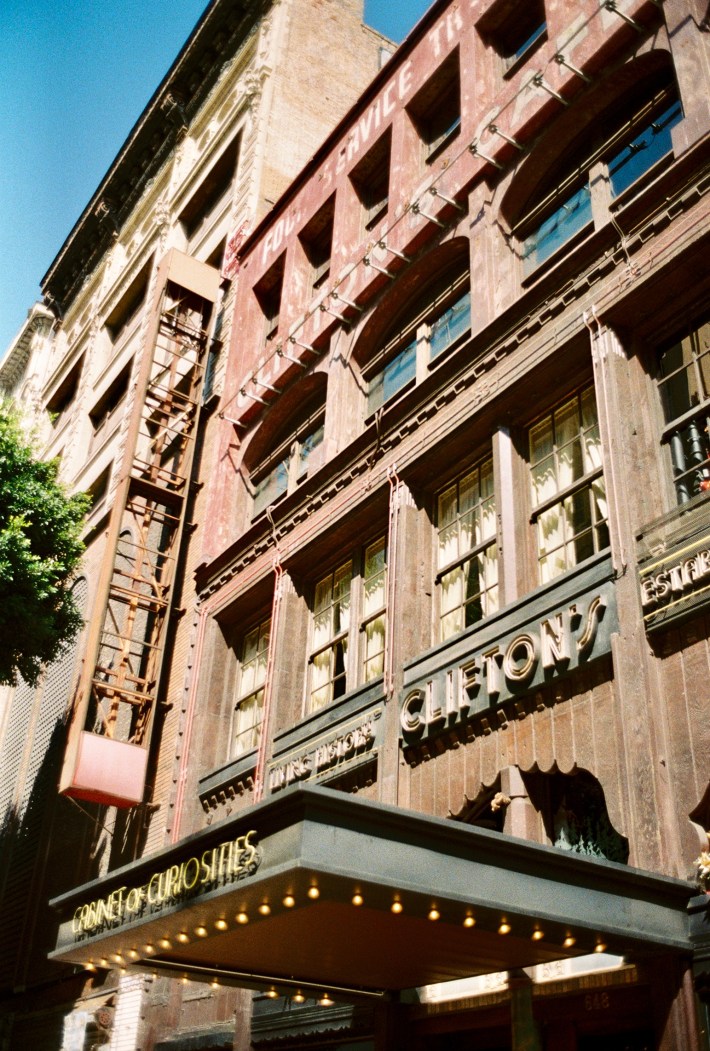

Clifton’s Cafeteria: Refuge from the Great Depression
Originally Clifton’s Brookdale, Clifton’s Cafeteria was founded by Clifford Clinton. He was moved by the circumstances of the Great Depression and wanted to provide a place where everybody could eat, regardless of their financial state. The establishment’s policy allowed patrons to “Dine Free Unless Delighted,” serving more than 10,000 individuals per day at its peak.
Clifton’s Brookdale was designed to teleport diners from the urban scene of Downtown Los Angeles to a whimsical, enchanted forest. The interior featured faux redwoods, scenic murals, a brook with limeade, and a 20-foot waterfall. This decor was distinct, reminiscent of something from Walt Disney’s imagination. Distinctly, the establishment maintained a loyal customer base despite the area’s decline following WWII.
In 2010, Andrew Meieran acquired Clifton’s and began a $14 million renovation. The newfound Clifton’s Republic opened in 2015, featuring a blend of its historic and kitschy charm with new attractions. For instance, the original concrete facade, hidden for almost 50 years, was unveiled, and the interior was transformed into a multi-story wonderland. This wonderland features the “Monarch Bar” on the second floor, accompanied by a chapel for children and a 40-foot-tall fake redwood tree in the chamber, the “Gothic Bar’ on the third floor with a booth dedicated to science fiction writer Ray Bradbury, the “Clinton Hall,” which showcases an event space with taxidermy created in collaboration with experts from the Natural History Museum and the “Pacific Seas,” a tiki bar on the fourth floor, featuring a restored Chris Craft boat as a DJ booth.
Maintaining the establishment’s original essence, every corner of Clifton’s inspires a sense of wonder.
Note: Clifton's is temporarily closed but set to re-open to the public in July, according to L.A. Times.
648 S Broadway, Los Angeles, CA 90014
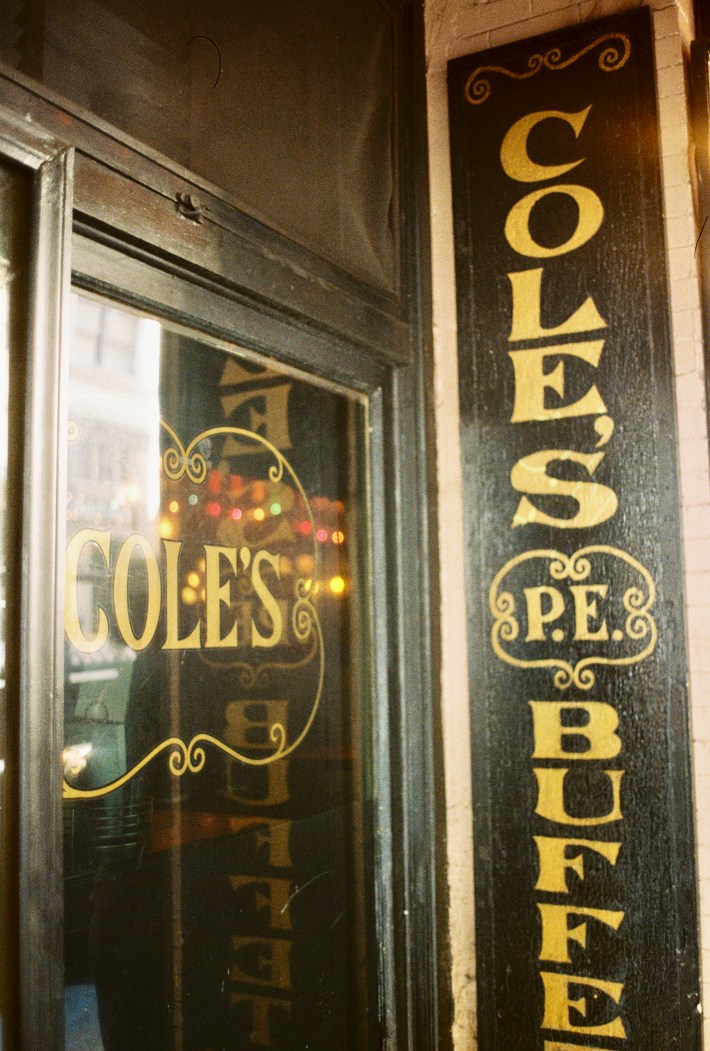
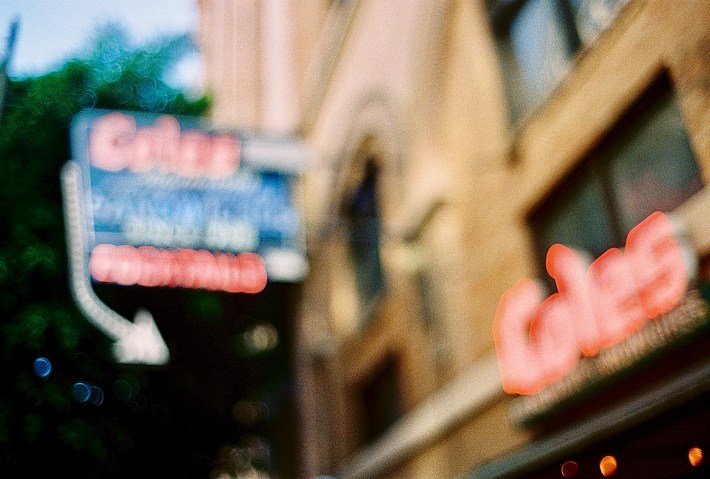
Cole’s French Dip: Where Every Sandwich Tells a Story
D.T.L.A.’s historic Cole’s was established in 1908 by Henry Cole. The building, which also served as the terminal for the Pacific Electric Railway, quickly became the ideal location for a downtown hot spot. Legend has it that Cole’s French dip sandwich was a moment of serendipity. The tale goes: A regular customer with sore gums requested that his bread be dipped in the meat drippings to soften it. The customer enjoyed it so much that he came back for the dish. This story is a point of historical contention with Philippe the Original, a neighboring historic restaurant that claims to be the inventor of the French dip.
Fascinatingly, Cole’s operated as a secret speakeasy in a back room called “The Varnish.” The hidden bar gave Angelenos in “the know” a place to enjoy illegally made beverages that tasted so much better. As all establishments aged over a century, Cole’s is rumored to be haunted. Staff and patrons report supernatural occurrences over the years, including unexplainable noises, drops in temperature, and the eerie feeling of eyes on them.
Cole’s convenient location of its underground tunnels adds to the Los Angeles lore. These tunnels, initially intended for the city’s streetcar system, are said to have been used to move booze discreetly. Although there’s no saying if Cole utilized these tunnels, it seems that it would have been a missed opportunity for a Prohibition-era speakeasy not to have utilized the tunnels it was constructed above.
The lore of Cole’s is a tapestry of American history, ghost stories, and legendary culinary claims. Ultimately, whether it's the origin of a sandwich or the spirits of flappers with unfinished business, Cole’s remains a place where the modern Angeleno can be transported to a time where the provocativeness of secrecy made the drinks taste better.
118 E 6th St, Los Angeles, CA 90014







